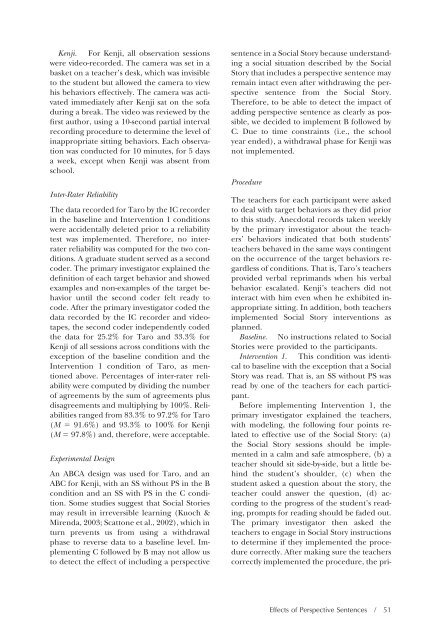Download the Journal (PDF) - Division on Autism and ...
Download the Journal (PDF) - Division on Autism and ...
Download the Journal (PDF) - Division on Autism and ...
Create successful ePaper yourself
Turn your PDF publications into a flip-book with our unique Google optimized e-Paper software.
Kenji. For Kenji, all observati<strong>on</strong> sessi<strong>on</strong>s<br />
were video-recorded. The camera was set in a<br />
basket <strong>on</strong> a teacher’s desk, which was invisible<br />
to <str<strong>on</strong>g>the</str<strong>on</strong>g> student but allowed <str<strong>on</strong>g>the</str<strong>on</strong>g> camera to view<br />
his behaviors effectively. The camera was activated<br />
immediately after Kenji sat <strong>on</strong> <str<strong>on</strong>g>the</str<strong>on</strong>g> sofa<br />
during a break. The video was reviewed by <str<strong>on</strong>g>the</str<strong>on</strong>g><br />
first author, using a 10-sec<strong>on</strong>d partial interval<br />
recording procedure to determine <str<strong>on</strong>g>the</str<strong>on</strong>g> level of<br />
inappropriate sitting behaviors. Each observati<strong>on</strong><br />
was c<strong>on</strong>ducted for 10 minutes, for 5 days<br />
a week, except when Kenji was absent from<br />
school.<br />
Inter-Rater Reliability<br />
The data recorded for Taro by <str<strong>on</strong>g>the</str<strong>on</strong>g> IC recorder<br />
in <str<strong>on</strong>g>the</str<strong>on</strong>g> baseline <strong>and</strong> Interventi<strong>on</strong> 1 c<strong>on</strong>diti<strong>on</strong>s<br />
were accidentally deleted prior to a reliability<br />
test was implemented. Therefore, no interrater<br />
reliability was computed for <str<strong>on</strong>g>the</str<strong>on</strong>g> two c<strong>on</strong>diti<strong>on</strong>s.<br />
A graduate student served as a sec<strong>on</strong>d<br />
coder. The primary investigator explained <str<strong>on</strong>g>the</str<strong>on</strong>g><br />
definiti<strong>on</strong> of each target behavior <strong>and</strong> showed<br />
examples <strong>and</strong> n<strong>on</strong>-examples of <str<strong>on</strong>g>the</str<strong>on</strong>g> target behavior<br />
until <str<strong>on</strong>g>the</str<strong>on</strong>g> sec<strong>on</strong>d coder felt ready to<br />
code. After <str<strong>on</strong>g>the</str<strong>on</strong>g> primary investigator coded <str<strong>on</strong>g>the</str<strong>on</strong>g><br />
data recorded by <str<strong>on</strong>g>the</str<strong>on</strong>g> IC recorder <strong>and</strong> videotapes,<br />
<str<strong>on</strong>g>the</str<strong>on</strong>g> sec<strong>on</strong>d coder independently coded<br />
<str<strong>on</strong>g>the</str<strong>on</strong>g> data for 25.2% for Taro <strong>and</strong> 33.3% for<br />
Kenji of all sessi<strong>on</strong>s across c<strong>on</strong>diti<strong>on</strong>s with <str<strong>on</strong>g>the</str<strong>on</strong>g><br />
excepti<strong>on</strong> of <str<strong>on</strong>g>the</str<strong>on</strong>g> baseline c<strong>on</strong>diti<strong>on</strong> <strong>and</strong> <str<strong>on</strong>g>the</str<strong>on</strong>g><br />
Interventi<strong>on</strong> 1 c<strong>on</strong>diti<strong>on</strong> of Taro, as menti<strong>on</strong>ed<br />
above. Percentages of inter-rater reliability<br />
were computed by dividing <str<strong>on</strong>g>the</str<strong>on</strong>g> number<br />
of agreements by <str<strong>on</strong>g>the</str<strong>on</strong>g> sum of agreements plus<br />
disagreements <strong>and</strong> multiplying by 100%. Reliabilities<br />
ranged from 83.3% to 97.2% for Taro<br />
(M 91.6%) <strong>and</strong> 93.3% to 100% for Kenji<br />
(M 97.8%) <strong>and</strong>, <str<strong>on</strong>g>the</str<strong>on</strong>g>refore, were acceptable.<br />
Experimental Design<br />
An ABCA design was used for Taro, <strong>and</strong> an<br />
ABC for Kenji, with an SS without PS in <str<strong>on</strong>g>the</str<strong>on</strong>g> B<br />
c<strong>on</strong>diti<strong>on</strong> <strong>and</strong> an SS with PS in <str<strong>on</strong>g>the</str<strong>on</strong>g> C c<strong>on</strong>diti<strong>on</strong>.<br />
Some studies suggest that Social Stories<br />
may result in irreversible learning (Kuoch &<br />
Mirenda, 2003; Scatt<strong>on</strong>e et al., 2002), which in<br />
turn prevents us from using a withdrawal<br />
phase to reverse data to a baseline level. Implementing<br />
C followed by B may not allow us<br />
to detect <str<strong>on</strong>g>the</str<strong>on</strong>g> effect of including a perspective<br />
sentence in a Social Story because underst<strong>and</strong>ing<br />
a social situati<strong>on</strong> described by <str<strong>on</strong>g>the</str<strong>on</strong>g> Social<br />
Story that includes a perspective sentence may<br />
remain intact even after withdrawing <str<strong>on</strong>g>the</str<strong>on</strong>g> perspective<br />
sentence from <str<strong>on</strong>g>the</str<strong>on</strong>g> Social Story.<br />
Therefore, to be able to detect <str<strong>on</strong>g>the</str<strong>on</strong>g> impact of<br />
adding perspective sentence as clearly as possible,<br />
we decided to implement B followed by<br />
C. Due to time c<strong>on</strong>straints (i.e., <str<strong>on</strong>g>the</str<strong>on</strong>g> school<br />
year ended), a withdrawal phase for Kenji was<br />
not implemented.<br />
Procedure<br />
The teachers for each participant were asked<br />
to deal with target behaviors as <str<strong>on</strong>g>the</str<strong>on</strong>g>y did prior<br />
to this study. Anecdotal records taken weekly<br />
by <str<strong>on</strong>g>the</str<strong>on</strong>g> primary investigator about <str<strong>on</strong>g>the</str<strong>on</strong>g> teachers’<br />
behaviors indicated that both students’<br />
teachers behaved in <str<strong>on</strong>g>the</str<strong>on</strong>g> same ways c<strong>on</strong>tingent<br />
<strong>on</strong> <str<strong>on</strong>g>the</str<strong>on</strong>g> occurrence of <str<strong>on</strong>g>the</str<strong>on</strong>g> target behaviors regardless<br />
of c<strong>on</strong>diti<strong>on</strong>s. That is, Taro’s teachers<br />
provided verbal reprim<strong>and</strong>s when his verbal<br />
behavior escalated. Kenji’s teachers did not<br />
interact with him even when he exhibited inappropriate<br />
sitting. In additi<strong>on</strong>, both teachers<br />
implemented Social Story interventi<strong>on</strong>s as<br />
planned.<br />
Baseline. No instructi<strong>on</strong>s related to Social<br />
Stories were provided to <str<strong>on</strong>g>the</str<strong>on</strong>g> participants.<br />
Interventi<strong>on</strong> 1. This c<strong>on</strong>diti<strong>on</strong> was identical<br />
to baseline with <str<strong>on</strong>g>the</str<strong>on</strong>g> excepti<strong>on</strong> that a Social<br />
Story was read. That is, an SS without PS was<br />
read by <strong>on</strong>e of <str<strong>on</strong>g>the</str<strong>on</strong>g> teachers for each participant.<br />
Before implementing Interventi<strong>on</strong> 1, <str<strong>on</strong>g>the</str<strong>on</strong>g><br />
primary investigator explained <str<strong>on</strong>g>the</str<strong>on</strong>g> teachers,<br />
with modeling, <str<strong>on</strong>g>the</str<strong>on</strong>g> following four points related<br />
to effective use of <str<strong>on</strong>g>the</str<strong>on</strong>g> Social Story: (a)<br />
<str<strong>on</strong>g>the</str<strong>on</strong>g> Social Story sessi<strong>on</strong>s should be implemented<br />
in a calm <strong>and</strong> safe atmosphere, (b) a<br />
teacher should sit side-by-side, but a little behind<br />
<str<strong>on</strong>g>the</str<strong>on</strong>g> student’s shoulder, (c) when <str<strong>on</strong>g>the</str<strong>on</strong>g><br />
student asked a questi<strong>on</strong> about <str<strong>on</strong>g>the</str<strong>on</strong>g> story, <str<strong>on</strong>g>the</str<strong>on</strong>g><br />
teacher could answer <str<strong>on</strong>g>the</str<strong>on</strong>g> questi<strong>on</strong>, (d) according<br />
to <str<strong>on</strong>g>the</str<strong>on</strong>g> progress of <str<strong>on</strong>g>the</str<strong>on</strong>g> student’s reading,<br />
prompts for reading should be faded out.<br />
The primary investigator <str<strong>on</strong>g>the</str<strong>on</strong>g>n asked <str<strong>on</strong>g>the</str<strong>on</strong>g><br />
teachers to engage in Social Story instructi<strong>on</strong>s<br />
to determine if <str<strong>on</strong>g>the</str<strong>on</strong>g>y implemented <str<strong>on</strong>g>the</str<strong>on</strong>g> procedure<br />
correctly. After making sure <str<strong>on</strong>g>the</str<strong>on</strong>g> teachers<br />
correctly implemented <str<strong>on</strong>g>the</str<strong>on</strong>g> procedure, <str<strong>on</strong>g>the</str<strong>on</strong>g> pri-<br />
Effects of Perspective Sentences / 51
















